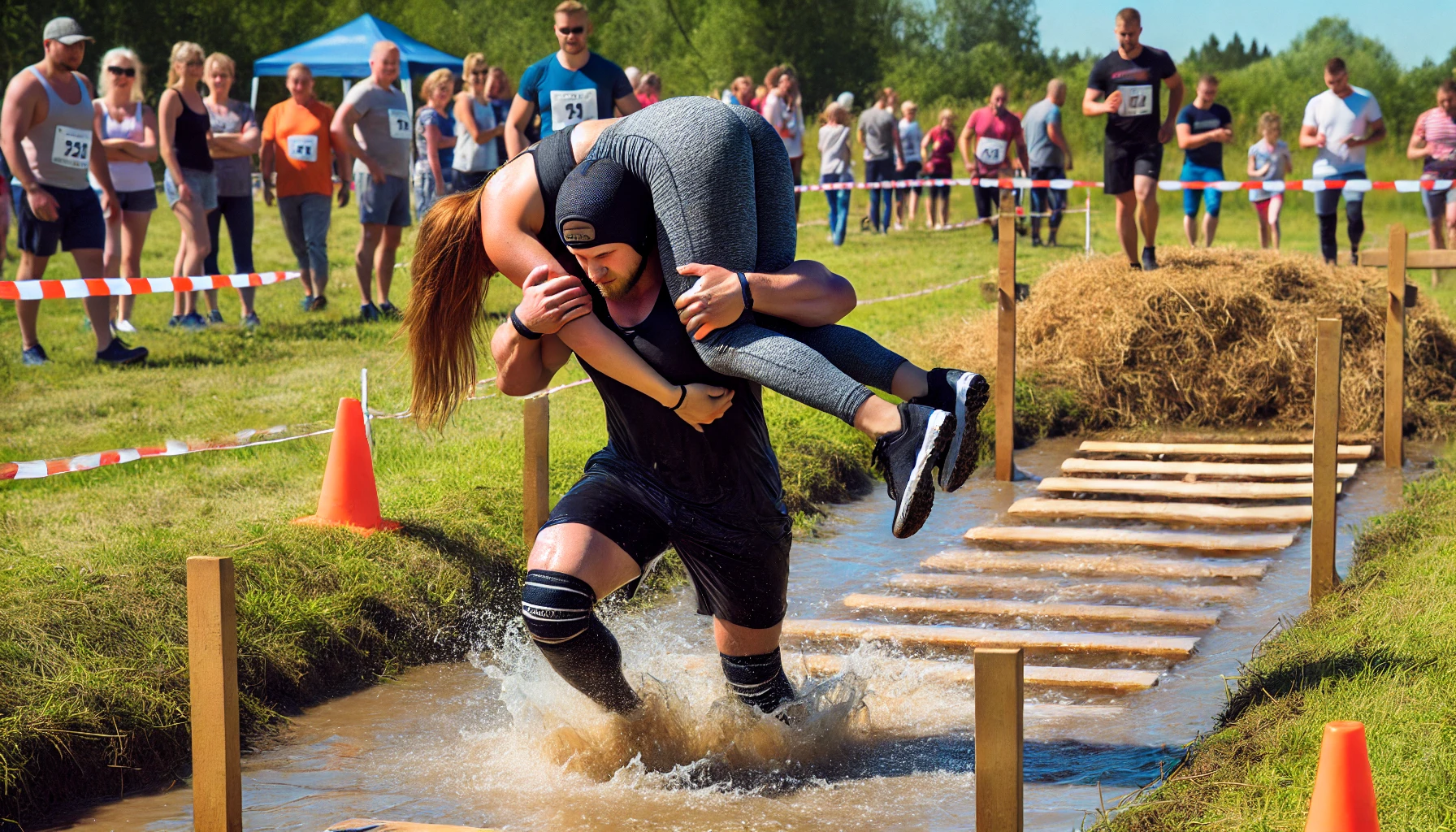
Wife carrying, a quirky and fun competition originating in Finland, has gained international popularity over the years. With a blend of athleticism, humor, and strategy, it attracts participants and spectators alike. While it may sound lighthearted, wife carrying is a serious sport with specific rules and guidelines that ensure fairness and safety. Whether you’re planning to participate or just curious about this unique event, it’s essential to understand the fundamental rules that govern the competition.
History of Wife Carrying: A Sport Born in Finland
The sport of wife carrying, or “eukonkanto” in Finnish, has an unusual and fascinating origin. It is said to have originated in the small town of Sonkajärvi, Finland, during the 19th century. There are several legends behind its inception, but one of the most popular stories involves a bandit named Herkko Rosvo-Ronkainen.
Herkko and his men were known for stealing food and women from nearby villages, often carrying them on their backs while fleeing. Over time, this unusual method of carrying evolved into a playful competition, where men would carry women (often their wives) through challenging obstacle courses. The first official Wife Carrying World Championship was held in Sonkajärvi in 1992, and since then, it has become an annual event that attracts participants from around the globe.
Today, wife carrying competitions take place in several countries, including the United States, Australia, and Estonia, but the Finnish championship remains the most prestigious event in the sport.
Origins of Wife Carrying
The Wife Carrying World Championships, known in Finnish as “eukonkanto,” originated in Sonkajärvi, Finland. The roots of the event are somewhat ambiguous, with some attributing it to an ancient practice where young men would steal women from neighboring villages. This historical context, albeit controversial, has evolved into a consensual and lighthearted competition that attracts competitors from all over the world.
The event has taken place annually since 1992 and has turned into a global phenomenon. The original idea was inspired by the legendary Finnish robber, Herkko Rosvo-Ronkainen, who is said to have tested his gang’s prowess by challenging them to carry heavy sacks on their backs, which eventually evolved into carrying live human beings.
Today, the championship not only promotes sportsmanship and fun but also highlights the Finnish penchant for inventing unusual sporting activities that gain international attention. The competition reflects a blend of historical folklore and modern-day festivity, making it a unique spectacle.
The Basic Rules of Wife Carrying
Though wife carrying may seem like a simple race, it follows a set of established rules to ensure a fair and entertaining competition. Understanding these rules is essential for anyone interested in participating in or watching the sport.
1. The Carrying Style is Flexible, but Safety is Paramount
One of the first things to know about wife carrying is that there are no strict guidelines regarding how the wife must be carried. Competitors are free to choose the carrying style that suits them best. However, the most popular and practical style is the “Estonian Carry,” where the wife hangs upside-down with her legs wrapped around the husband’s shoulders and her head near his lower back.
Other carrying styles include the piggyback and fireman’s carry, but these are less common due to their lack of stability. Regardless of the carrying style, safety is always a priority. Both participants must be mindful of their physical abilities to avoid accidents and injuries during the race.
In official competitions, there are often medical personnel on standby to assist in case of an injury. The wife must also wear a helmet for added safety, and both participants should ensure they are comfortable with the selected carry before the event.
2. Minimum Weight and Height Requirements
To ensure fairness in the competition, wife carrying has specific weight and height requirements for participants. The wife must weigh at least 49 kilograms (108 pounds). If she weighs less than this, she must carry an additional weight, such as a backpack filled with sand, to meet the minimum requirement.
This rule prevents an unfair advantage for couples where the wife is significantly lighter, ensuring that the competition is more about the husband’s strength and agility rather than just the wife’s weight. However, there are no minimum weight or height requirements for the husband, allowing men of various sizes and builds to participate.
In addition to weight requirements, participants must be at least 17 years old to compete. This ensures that both the wife and husband have reached physical maturity and are capable of handling the demands of the race.
3. The Course Must Include Obstacles
Wife carrying courses are designed to be challenging, requiring strength, agility, and strategy. The standard course is 253.5 meters (approximately 830 feet) long and includes a variety of obstacles, such as water hazards, sandpits, and fences.
Each course must have at least one dry obstacle (such as hurdles) and one wet obstacle (like a pool or water-filled ditch). Competitors must navigate these obstacles while carrying their wives, adding a layer of difficulty to the race. The water obstacle, often a shallow pool, can be particularly tricky as it may cause the competitors to lose their balance.
While the course design may vary between different competitions, the Finnish championship serves as the model for most events around the world. The varying nature of the course ensures that wife carrying is not just a test of speed but also of endurance, balance, and teamwork.
Penalties and Time Adjustments in Wife Carrying
As in any sport, wife carrying includes penalties and time adjustments to ensure fairness and prevent unsportsmanlike behavior. Penalties are typically added to the competitor’s final time if they fail to follow the rules or make mistakes during the race.
1. Dropping the Wife
One of the most common penalties in wife carrying occurs when the husband accidentally drops his wife. In such cases, a penalty of 15 seconds is added to the couple’s final race time. While dropping the wife is not disqualifying, it can be a significant setback for competitors, especially in close races where every second counts.
To minimize the risk of dropping the wife, many couples practice extensively before the event, working on building strength, balance, and teamwork. Dropping penalties serve as a reminder that while the competition is lighthearted, it requires skill and focus.
In some competitions, there may be additional penalties if the wife is dropped more than once, or if the competitors fail to complete a particular obstacle correctly.
2. False Starts
As in any race, false starts can occur in wife carrying competitions. If a competitor begins running before the starting signal, they may face a time penalty. The exact penalty for a false start can vary depending on the competition, but it typically ranges from 5 to 10 seconds.
False starts are relatively rare, as participants are usually focused on ensuring their wife is securely in place before the race begins. However, in the excitement of the event, mistakes can happen. Competitors are encouraged to stay calm and wait for the official starting signal to avoid unnecessary penalties.
3. Time Adjustments for Obstacles
Certain obstacles within the racecourse may have time penalties associated with them if not completed correctly. For example, if a competitor fails to properly cross a hurdle or falls into the water obstacle, a time penalty may be added to their final score.
Time adjustments can vary by competition, but they serve to maintain the integrity of the sport. Competitors must balance speed with precision as they navigate the obstacles, ensuring they complete each challenge correctly while minimizing the risk of incurring penalties.
Training Tips for Aspiring Wife-Carrying Champions
While wife carrying is a fun and lighthearted sport, it requires serious preparation to perform well. Training for the event involves not only physical conditioning but also working together as a team. Here are some essential training tips for aspiring champions.
1. Build Core and Leg Strength
Wife carrying is a physically demanding sport that requires significant core and leg strength. Husbands, in particular, need to develop the muscle endurance required to carry their wife through a course filled with obstacles. Squats, lunges, and deadlifts are excellent exercises for building the necessary leg and core strength.
In addition to these traditional strength exercises, practicing with your wife in the Estonian carry position can help build the specific muscles you’ll need during the race. Carrying a human being is different from lifting weights, so it’s essential to get comfortable with the unique balance and movement required in wife carrying.
2. Practice Balance and Coordination
Carrying your wife over an obstacle course requires excellent balance and coordination. It’s easy to lose your footing when navigating hurdles or water obstacles, especially with the added weight of your partner. Incorporating exercises that improve balance, such as yoga or stability ball workouts, can be helpful.
Practicing on uneven terrain or adding simulated obstacles to your training routine can also prepare you for the unpredictable nature of the racecourse. Working together with your wife to develop a smooth and efficient carrying style will help you navigate the course with minimal issues.
3. Focus on Endurance
While wife carrying races are relatively short (typically less than 300 meters), the combination of obstacles, carrying weight, and maintaining balance can be exhausting. Endurance training is key to performing well throughout the entire course.
Running, especially while carrying a weighted object or your wife, can help build the stamina needed to compete. Interval training, where you alternate between high-intensity sprints and lower-intensity recovery periods, can also improve your endurance and speed, making it easier to complete the race without fatigue setting in.
Fun Facts and Global Popularity of Wife Carrying
While wife carrying may have originated in Finland, its popularity has spread to other parts of the world. The sport has become a unique and entertaining event, often drawing large crowds of spectators. Here are some fun facts about the global appeal of wife carrying.
1. The United States Hosts Multiple Competitions
Wife carrying has gained popularity in the United States, with several competitions taking place across the country. One of the most well-known events is the North American Wife Carrying Championship, held annually in Maine. Winners of the North American championship often receive a prize similar to the Finnish tradition—beer equivalent to the wife’s weight.
While the competition is fierce, the atmosphere is fun and celebratory, with participants coming from various backgrounds to enjoy the challenge. Competitors are not required to be married, so partners, friends, and even strangers have competed together in the event.
2. Estonia is a Close Competitor to Finland
While Finland is the birthplace of wife carrying, Estonia is known for producing some of the best competitors in the sport. In fact, Estonian couples have dominated many international wife-carrying competitions, often outperforming Finnish participants.
The rivalry between Finland and Estonia has only added to the excitement of the sport. Estonian competitors typically use the Estonian Carry, a technique that has proven to be highly effective in winning races.
3. The Prizes Are as Quirky as the Sport
The prize for winning a wife-carrying competition is not your typical trophy or medal. In the Finnish Wife Carrying World Championship, the winner receives the wife’s weight in beer. This quirky prize adds to the fun and lighthearted nature of the event. Some competitions also offer other rewards, such as cash prizes or vacations, but the beer prize remains a fan favorite.
Conclusion
Wife carrying may be an unusual sport, but its blend of physical challenge, humor, and teamwork has made it a beloved event worldwide. With clear rules, specific training requirements, and a unique sense of fun, it’s no wonder that competitors and spectators alike are drawn to this quirky competition. Whether you’re considering entering a race or just want to enjoy the spectacle, wife carrying offers a memorable experience that combines athleticism with humor in a truly one-of-a-kind way.








